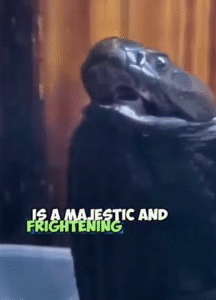The Black Cobra: The World’s Most Fascinating Snake
Among the many awe-inspiring serpents that slither across the globe, the Black Cobra stands out as one of the most fascinating and feared. Known for its lethal venom, sleek appearance, and dramatic displays, the Black Cobra is a creature that evokes both admiration and dread. Though not as commonly discussed as its more famous relatives like the King Cobra, the Black Cobra is an incredible predator with unique features that make it a subject of scientific intrigue and cultural legend.
Scientifically known as Naja melanoleuca in parts of Africa or Naja naja in India, depending on the region and coloration, the term “Black Cobra” is often used to describe highly melanistic forms of cobras—those with unusually dark or entirely black scales. These snakes are typically found in dense forests, savannas, and scrublands, where their dark coloration helps them blend into shadows, making them nearly invisible to both prey and predators. Their sleek, jet-black bodies glisten in the light, making them one of the most visually striking snakes in the world.
One of the Black Cobra’s most iconic features is its hood—a defensive adaptation that it flares out when threatened. When confronted, the cobra lifts the front third of its body off the ground, spreads its hood, and hisses loudly, warning potential threats to back off. This display is not just for show. The Black Cobra is capable of delivering a deadly bite. Its venom is a potent neurotoxin, affecting the nervous system and potentially leading to paralysis or death if not treated quickly. In some species, the venom also contains cytotoxins that cause severe tissue damage.
Despite its deadly abilities, the Black Cobra prefers to avoid confrontation. It usually strikes only when cornered or provoked. In the wild, it plays a vital role in maintaining ecological balance by controlling populations of rodents and other small animals. Because it often lives near human settlements in rural areas, it is both revered and feared by local communities. In many cultures, cobras are symbols of power, transformation, and protection, and the Black Cobra, with its mysterious appearance, often holds special spiritual significance.
Interestingly, cobras—including the Black Cobra—are among the few snakes that “hear” through ground vibrations rather than airborne sounds. While they lack external ears, they sense vibrations through their jawbones, which helps them detect approaching animals or threats. They also possess excellent eyesight for snakes, allowing them to strike with deadly accuracy.
Conservationists have expressed concern over the declining population of cobras due to habitat destruction and illegal wildlife trade. While not all Black Cobras are listed as endangered, their habitats are increasingly threatened by deforestation and human encroachment.
In summary, the Black Cobra is more than just a snake—it is a symbol of nature’s beauty and danger intertwined. Its enigmatic presence, deadly elegance, and crucial ecological role make it one of the most fascinating reptiles on the planet. Whether feared or revered, the Black Cobra commands respect, reminding us of the wild mysteries that still slither in the shadows.

